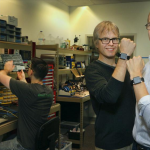Warfighter Movement – Defense Innovation Showcase
APDM has been selected to present Continuous Monitoring technology and Mobility Lab at the Defense Energy Innovation Summit & Showcase December 1-3 in Austin, Texas. Come visit the APDM booth to learn about the applications of wearable technology.
The Defense Energy Innovation Summit & Showcase is the Nation’s largest Defense Innovation Showcase, featuring technologies demonstrating solutions to military and industry leadership. Participating offices include the Department of Defense, Army, Navy, Air Force, Department of Energy, NASA, and many more.
Mobility Lab’s value proposition is to better understand healthy or recovering soldier’s balance and mobility. This will result in improved diagnosis and interventions, enabling troops to resume their military career or fulfill their remaining service commitment, and providing veterans with better health outcomes. Battlefield injuries and the physical demands of intense training and carrying heavy loads in combat zones often leave service members susceptible to developing balance and mobility impairments at a younger age. Balance and mobility are critical for important health decisions for soldiers – helping to determine what load they can carry for how long, when they should be taken out of the field due to injury, what therapies are appropriate for these injuries, and when they are fit for re-deployment.
Opal sensors are also being featured for Continuous Monitoring of movement. Assessment in a clinic may not adequately reflect mobility in daily life. Opals provide a Continuous Monitoring system to see objective measures of mobility and balance throughout the day.
Balance and mobility are also important for understanding the long-term effects of service on aging Veterans. Accurate and objective measures of balance and mobility are difficult to obtain, however, and are typically constrained to laboratories where large, complex motion capture systems can be installed. Mobility Lab and Continuous Monitoring with Opals will be especially valuable in clinical and military research that requires portability, automation, and high accuracy in clinical and home environments. APDM technology will provide relevant, objective metrics to evaluate service members’ movement during spontaneous activities.
Warfighter balance and mobility was featured in a recent edition of Gait & Posture. The featured paper, “Quantifying Performance and Effects of Load Carriage During a Challenging Balancing Task Using an Array of Wireless Inertial Sensors” by Stephen Cain, et al., exploited the use of APDM Opals to provide unobtrusive measurements of body segment kinematics in a real-world environment. The team studied an obstacle within the Marine Corps Load Effects Assessment Program (MC-LEAP). The challenge involves a zigzag and sloped balance beam to assess balance performance and the effects of load and equipment on soldiers. Until this study, the only metric used for assessment of this challenge was traverse time. While time is related to performance, it does not provide any in-depth information about biomechanical movements and how they are altered by load. The team looked at traverse time, double support time, stride duration, planar acceleration, and torso range of motion.
The study showed numerous valuable findings with and without load carriage. With load, an increase in traverse time and a more cautious gait was seen. Double support time and stride duration increased, and torso lateral flexion and lateral acceleration of the sacrum decreased.
The findings of this study are indicative of what Mobility Lab and Continuous Monitoring with Opals can provide those interested with warfighter performance. Understanding how soldier movement is affected in mission, rescue or emergency circumstances plays an important role in overall health and performance decision-making.
For more information about Mobility Lab, click here.
For more information about Continuous Monitoring, click here.





